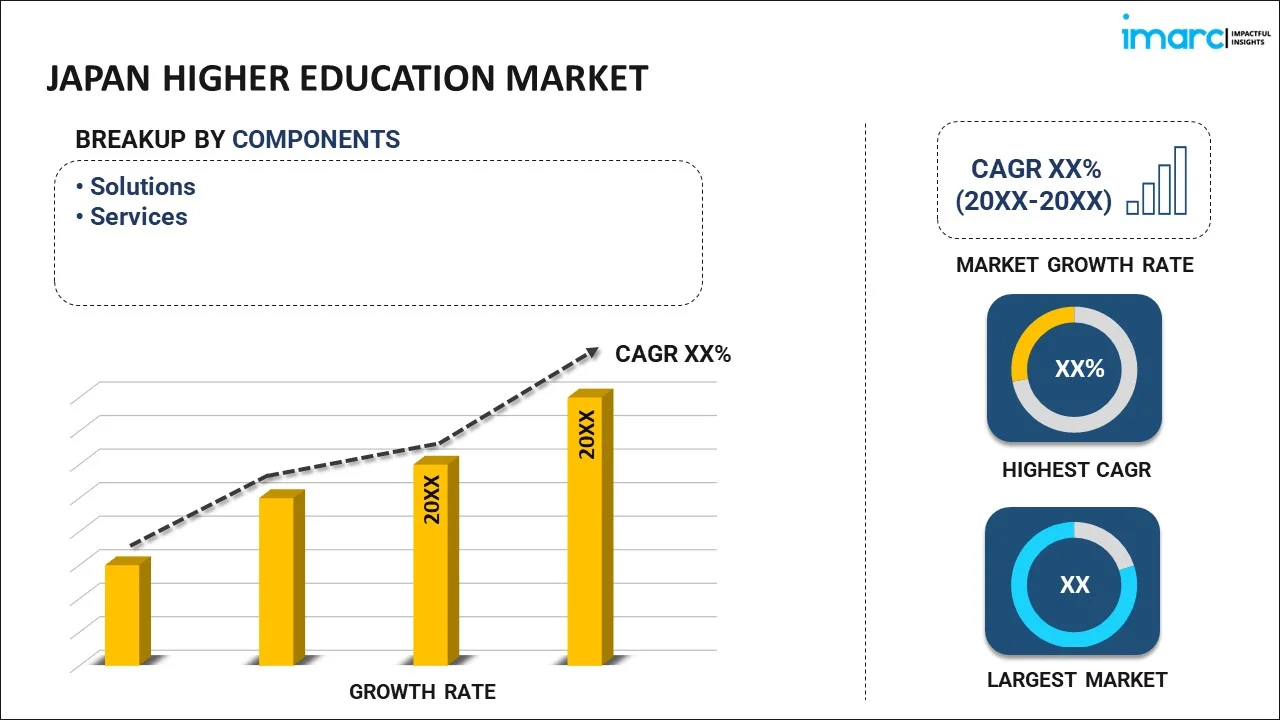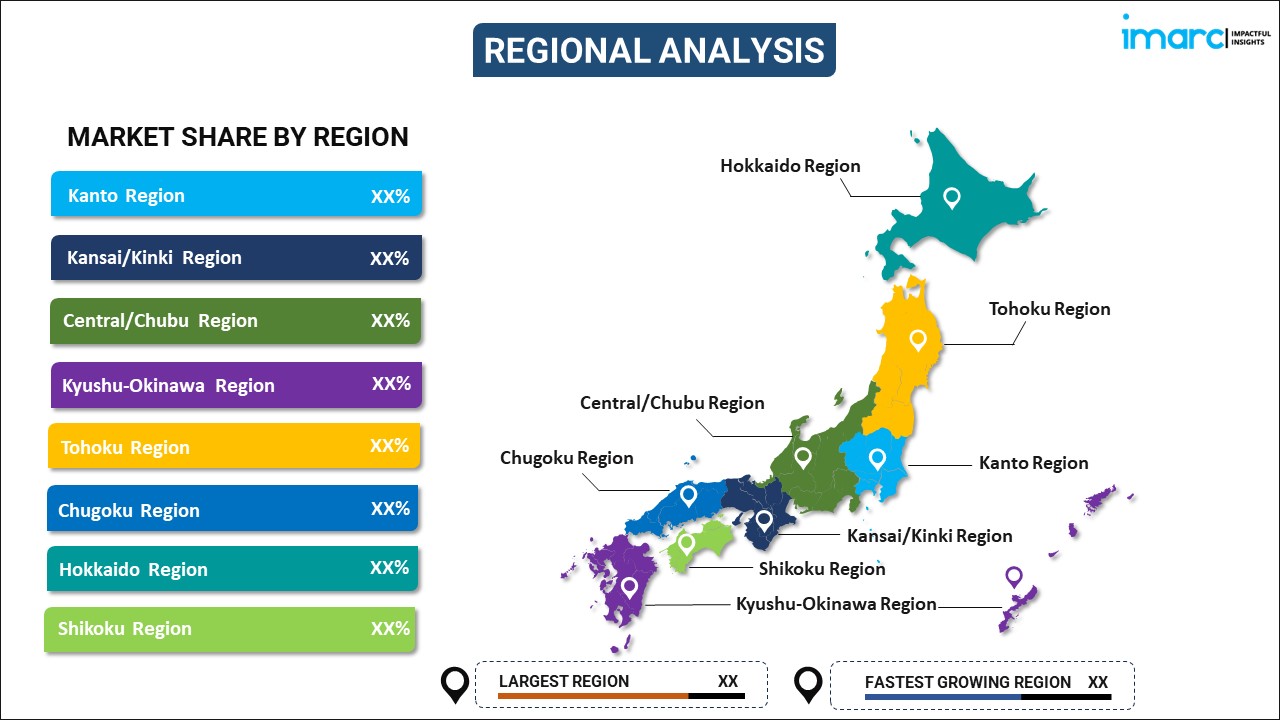
Japan Higher Education Market Report by Component (Solutions, Services), Deployment Mode (On-premises, Cloud-based), Course Type (Arts, Economics, Engineering, Law, Science, and Others), Learning Type (Online, Offline), End User (State Universities, Community Colleges, Private Colleges), and Region 2025-2033
Market Overview:
Japan higher education market size reached USD 21.03 Billion in 2024. Looking forward, IMARC Group expects the market to reach USD 28.70 Billion by 2033, exhibiting a growth rate (CAGR) of 3.42% during 2025-2033. The increasing demand for lifelong learning and continuing education programs, coupled with the integration of technology into education, such as online learning platforms, virtual classrooms, and digital resources, is primarily driving the market.
|
Report Attribute
|
Key Statistics
|
|---|---|
|
Base Year
|
2024 |
|
Forecast Years
|
2025-2033 |
|
Historical Years
|
2019-2024
|
| Market Size in 2024 | USD 21.03 Billion |
| Market Forecast in 2033 | USD 28.70 Billion |
| Market Growth Rate (2025-2033) | 3.42% |
Higher education refers to the tertiary level of instruction that follows secondary schooling. Encompassing both undergraduate and postgraduate studies, it offers a diverse range of academic, professional, and vocational programs leading to certificates, diplomas, and degrees. Institutions such as universities, colleges, and technical schools provide these programs, fostering critical thinking, specialized skills, and comprehensive knowledge in specific disciplines. These institutions often engage in research, pushing the boundaries of human understanding and driving innovation. For students, higher education represents an opportunity to delve deeper into areas of interest, increase employability, and achieve personal and professional growth. It plays a pivotal role in societal advancement by producing informed citizens and skilled professionals. However, access to higher education, its cost, and its relevance are ongoing subjects of debate. Nevertheless, its profound impact on individual lives and society at large cannot be underestimated. As society evolves, so does the nature and role of higher education, adapting to the changing needs of the community.
Japan Higher Education Market Trends:
The higher education market in Japan is influenced by various factors that shape the landscape of tertiary education. Firstly, demographic trends play a pivotal role in driving demand for higher education. As the regional population continues to grow, so does the pool of potential students, leading to increased enrollment rates. Furthermore, economic conditions significantly impact the higher education market. During economic downturns, individuals often seek to enhance their skills and qualifications to remain competitive in the job market, thus driving enrollment. Moreover, evolving industry needs and the demand for specialized skills drive students to seek education in fields that are relevant to the job market. As industries evolve, higher education institutions must respond with updated programs and curricula to meet these demands. Additionally, government policies and regulations, including funding, accreditation standards, and immigration policies for students, can significantly affect the higher education market. Lastly, the emerging popularity of online and blended learning options, which offer flexibility and accessibility to a broader range of students, is expected to drive the higher education market in Japan during the forecast period.
Japan Higher Education Market Segmentation:
IMARC Group provides an analysis of the key trends in each segment of the market, along with forecasts at the country level for 2025-2033. Our report has categorized the market based on component, deployment mode, course type, learning type, and end user.
Component Insights:

- Solutions
- Student Information Management System
- Content Collaboration
- Data Security and Compliance
- Campus Management
- Others
- Services
- Managed Services
- Professional Services
The report has provided a detailed breakup and analysis of the market based on the component. This includes solutions (student information management system, content collaboration, data security and compliance, campus management, and others) and services (managed services and professional services).
Deployment Mode Insights:
- On-premises
- Cloud-based
A detailed breakup and analysis of the market based on the deployment mode have also been provided in the report. This includes on-premises and cloud-based.
Course Type Insights:
- Arts
- Economics
- Engineering
- Law
- Science
- Others
The report has provided a detailed breakup and analysis of the market based on the course type. This includes arts, economics, engineering, law, science, and others.
Learning Type Insights:
- Online
- Offline
A detailed breakup and analysis of the market based on the learning type have also been provided in the report. This includes online and offline.
End User Insights:
- State Universities
- Community Colleges
- Private Colleges
The report has provided a detailed breakup and analysis of the market based on the end user. This includes state universities, community colleges, and private colleges.
Regional Insights:

- Kanto Region
- Kansai/Kinki Region
- Central/ Chubu Region
- Kyushu-Okinawa Region
- Tohoku Region
- Chugoku Region
- Hokkaido Region
- Shikoku Region
The report has also provided a comprehensive analysis of all the major regional markets, which include Kanto Region, Kansai/Kinki Region, Central/ Chubu Region, Kyushu-Okinawa Region, Tohoku Region, Chugoku Region, Hokkaido Region, and Shikoku Region.
Competitive Landscape:
The market research report has also provided a comprehensive analysis of the competitive landscape. Competitive analysis such as market structure, key player positioning, top winning strategies, competitive dashboard, and company evaluation quadrant has been covered in the report. Also, detailed profiles of all major companies have been provided.
Japan Higher Education Market Report Coverage:
| Report Features | Details |
|---|---|
| Base Year of the Analysis | 2024 |
| Historical Period | 2019-2024 |
| Forecast Period | 2025-2033 |
| Units | Billion USD |
| Scope of the Report | Exploration of Historical Trends and Market Outlook, Industry Catalysts and Challenges, Segment-Wise Historical and Future Market Assessment:
|
| Components Covered |
|
| Deployment Modes Covered | On-premises, Cloud-based |
| Course Types Covered | Arts, Economics, Engineering, Law, Science, Others |
| Learning Types Covered | Online, Offline |
| End Users Covered | State Universities, Community Colleges, Private Colleges |
| Regions Covered | Kanto Region, Kansai/Kinki Region, Central/ Chubu Region, Kyushu-Okinawa Region, Tohoku Region, Chugoku Region, Hokkaido Region, Shikoku Region |
| Customization Scope | 10% Free Customization |
| Post-Sale Analyst Support | 10-12 Weeks |
| Delivery Format | PDF and Excel through Email (We can also provide the editable version of the report in PPT/Word format on special request) |
Key Questions Answered in This Report:
- How has the Japan higher education market performed so far and how will it perform in the coming years?
- What has been the impact of COVID-19 on the Japan higher education market?
- What is the breakup of the Japan higher education market on the basis of component?
- What is the breakup of the Japan higher education market on the basis of deployment mode?
- What is the breakup of the Japan higher education market on the basis of course type?
- What is the breakup of the Japan higher education market on the basis of learning type?
- What is the breakup of the Japan higher education market on the basis of end user?
- What are the various stages in the value chain of the Japan higher education market?
- What are the key driving factors and challenges in the Japan higher education?
- What is the structure of the Japan higher education market and who are the key players?
- What is the degree of competition in the Japan higher education market?
Key Benefits for Stakeholders:
- IMARC’s industry report offers a comprehensive quantitative analysis of various market segments, historical and current market trends, market forecasts, and dynamics of the Japan higher education market from 2019-2033.
- The research report provides the latest information on the market drivers, challenges, and opportunities in the Japan higher education market.
- Porter's five forces analysis assist stakeholders in assessing the impact of new entrants, competitive rivalry, supplier power, buyer power, and the threat of substitution. It helps stakeholders to analyze the level of competition within the Japan higher education industry and its attractiveness.
- Competitive landscape allows stakeholders to understand their competitive environment and provides an insight into the current positions of key players in the market.
Need more help?
- Speak to our experienced analysts for insights on the current market scenarios.
- Include additional segments and countries to customize the report as per your requirement.
- Gain an unparalleled competitive advantage in your domain by understanding how to utilize the report and positively impacting your operations and revenue.
- For further assistance, please connect with our analysts.
 Inquire Before Buying
Inquire Before Buying
 Speak to an Analyst
Speak to an Analyst
 Request Brochure
Request Brochure
 Request Customization
Request Customization




.webp)




.webp)












